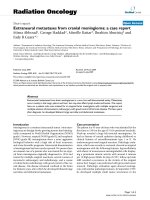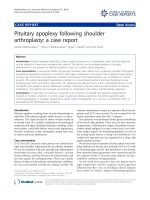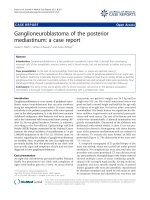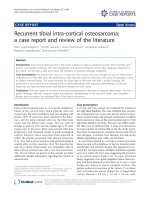Báo cáo y học: "High dose nitroglycerin treatment in a patient with cardiac arrest: a case report" pot
Bạn đang xem bản rút gọn của tài liệu. Xem và tải ngay bản đầy đủ của tài liệu tại đây (180.68 KB, 4 trang )
Case report
Open Access
High dose nitroglycerin treatment in a patient with cardiac arrest:
a case report
Maya Guglin* and Gilbert Postler
Address: Department of Cardiology, University of South Florida, 2 Tampa General Circle, Tampa, FL 33606, USA
Email: MG* - ; GP -
* Corresponding author
Received: 11 January 2009 Accepted: 24 March 2009 Published: 10 August 2009
Journal of Medical Case Reports 2009, 3:8782 doi: 10.4076/1752-1947-3-8782
This article is available from: />© 2009 Guglin and Postler; licensee Cases Network Ltd.
This is an Open Access article distributed under the terms of the Creative Commons Attribution License (
/>which permits unrestricted use, distribution, and reproduction in any medium, provided the original work is properly cited.
Abstract
Introduction: Vasodilators like nitroglycerin or nitroprusside improve hemodynamics in patients
with advanced heart failure. However, using these agents in critical conditions is limited because of
their ability to decrease systemic blood pressure.
Case presentation: We report the rapid effect of high dose intravenous nitroglycerin treatment in
an 86-year-old man after cardiac arrest and prolonged resuscitation, together with previous
observations and a brief review of the literature.
Conclusion: High dose intravenous nitroglycerin can be beneficial in cardiac arrest.
Introduction
Vasodilators like nitroglycerin (NTG) or nitroprusside
improve hemodynamics in patients with advanced heart
failure ( HF). However, using these agents in critical
conditions is limited because of their ability to decrease
systemic blood pressure (BP). We report a case of
successful use of high-dose intravenous NTG in a patient
after cardiac arrest.
Case presentation
An 86-year-old Caucasian man with a history of coronary
artery disease, coronary artery bypass surgery in 1999,
hyperlipidemia and hypertension, came to the out-patient
laboratory of the hospital to check the results of his
blood tests. His home medications included 40 mg daily
of lisinopril, 40 mg daily of furosemide, and 80 mg daily
of simvastatin. He complained of sudden pressure-like
chest discomfort and collapsed in the waiting area. The
“code blue” emergency call was given. The team respond-
ing to the call applied an automated external defibrillator
and delivered a shock. The recorded rhythm indicated
ventricular tachycardia. Consequently, the patient was
given 300 mg of amiodarone, which resulted in the
restoration of his normal sinus rhythm. The ventricular
tachycardia was immediately restarted. For the next 16
minutes, ventricular tachycardia and ventricular fibrilla-
tion were treated with additional shocks and multiple
doses of epinephrine, amiodarone and lidocaine.
After 16 minutes of resuscitation, the patient’s normal
sinus rhythm was restored, and he was transferred to the
medical intensive care unit, intubated and started on
mechanical ventilation. He was unconscious, and his
BP was 98/58. The laboratory tests drawn at this time
Page 1 of 4
(page number not for citation purposes)
showed his white blood cells at 16.6 G/L, hemoglobin
10.2 G/dL and platelets 175 G/L. His coagulation test
results and chemistry were normal.
After 15 minutes of normal rhythm, the patient again
developed ventricular tachycardia. Following the
advanced cardiac life supp ort protocol, resuscitation
efforts continued for 50 more minutes, using epinephrine,
vasopressin, amiodarone, lidocaine, magnesium and
bicarbonate. Eventually, the monitor recorded asystole
and the patient had no spontaneous respirations, pulse,
BP, or heart sounds. Based on previous experience with a
patient, we gave him 4 mg of NTG intravenously as a bolus
as a last resort. After three minutes of chest compressions
the patient was pronounced dead and all resuscitative
efforts were stopped.
Two minutes later, however, the nurse discovered that the
patient was breathing, in normal sinus rhythm, with a
palpable pulse, and a BP of 137/58 mmHg. The ventilator
was turned back on, and the patient was treated with NTG,
heparin, amiodarone drips and aspirin.
The next morning, the patient’s troponin I level was
elevated at 23.9 ng/mL (upper normal limit 0.05), which
is consistent with acute myocardial infarction (MI). His
electrocardiogram displayed normal sinus rhythm and his
left bundle branch block was the same as pre-event
recordings. His chest X-ray was negative. He was extubated
on the second hospital day, with his mental status
gradually returning to his baseline. His BP remained
stable at 120-150 mmHg systolic. An echo displayed a
reduced ejection fraction of 30% with global hypokinesis
and an akinetic inferior wall. An adenosine-sestamibi
stress test displayed areas of infarction of the inferolateral
and anterolateral walls with a small area of reversibility.
Taking his advanced age into account, we decided against
performing cardiac catheterization. He subsequently
underwent implantation of an automated defibrillator
and was discharged from the hospital on day 18.
Discussion
Only one known similar case has been previously reported
in the English language literature. In 1984, Ward and Reid
[1] described a 64-year-old woman with an acute MI who
had a cardiac arrest. She had ventricular tachycardia and
was cardioverted to sinus bradycardia, intubated and
ventilated. She received atropine, epinephrine, and cal-
cium chloride, and had pericardiocentesis and rapid saline
infusions. However, she still did not have a detectable BP.
She was then started on NTG at 1 mg/minute. In three
minutes, her BP was 80/60 mmHg. Several days later, her
cardiac catheterization demonstrated severe coronary
artery disease and a large anteroapical and septal infarction
with aneurysm formation. She was eventually discharged
from the hospital.
In 1990 [2], and in 1997 [3], we reported a case series in
which the infusion of high doses of NTG resulted in rapid
improvement in some patients with cardiogenic shock due
to acute MI or advanced heart failure. The results are
summarized in Table 1.
High doses of NTG were used in 22 patients, including
14 patients with acute MI and eight patients with advanced
HF. All patients had critically low BP measured by cuff,
and 18 had an unmeasurable BP and pulse. They all had
cold and mottl ed skin and increased ce ntral venous
pressure. Eleven patients had rales in the lungs, three
had pulmonary edema, and one had anasarca. The doses
of NTG used in each patient, as well as the times of
infusions, are listed in Table 1. BP became obtainable or
increased in 20 of 22 patients immediately after intrave-
nous NTG was administered. In the end, 13 patients
survived.
We recently presented these data to a group of cardiology
fellows, one of whom administered the bolus of NTG to
our patient in this case.
According to current recommendations, intravenous NTG
is contraindicated if systolic BP is below 90 mmHg.
Hemodynamic properties of vasodilators, and of nitrates
in particular, were extensively studied in the 1970s and
1980s, although usually not in terminal patients with no
BP. In 1972, Franciosa et al. [4] reported that intravenous
sodium nitroprusside increased cardiac output and
decreased wedge pressure in 15 patients with acute MI
and elevated left ventricular filling pressure. Their BP was
not allowed to fall below 95 mmHg, with the average drop
in systolic BP at only 26 mmHg. Similar results were
achieved in severe HF secondary to ischemic or dilated
cardiomyopathy [5].
In 1975, Chatterjee et al. [6] described a beneficial effect
of nitroprusside in 43 patients with acute MI and severe
pump failure. In their series, the cardiac index increased
from 1.7 to 2.2 L/min/m
2
, while the left ventricular filling
pressure decreased by 35%. The mean arterial pressure
decreased from 83 ± 1.5 to 73 ± 1.7 mmHg. Although
these patients had BP of ≤90 mm Hg by cuff, only 17 had
clinical shock syndrome.
In another study evaluating incremental doses of intra-
venous NTG in patients with left ventricular failure the
maximal hemodynamic benefit, in terms of decrease in
wedge pressure and increase in cardiac index, was
obtained at 160 mcg/min, which represented the highest
dose tested [7].
Page 2 of 4
(page number not for citation purposes)
Journal of Medical Case Reports 2009, 3:8782 />Stevenson et al. [8] found that after-load reduction with
nitroprusside in severe HF leads to smaller left ventricular
end-diastolic volume and less severe mitral regurgitation,
resulting in greater forward flow. The BP cutoff for
nitroprusside infusion was 80 mmHg. In the emergency
department, boluses of intravenous NTG ranging from
0.05 mg to 0.4 mg repeated every five minutes as needed
for chest pain were used successfully to treat ischemia due
to MI or unstable angina. Systolic BP was not allowed to
drop below 95 mmHg [9].
Recently, there has been increased interest in high dose
intravenous nitrates. Cotter et al. [10] randomized patients
with pulmonary edema into cohorts receiving isosorbide
dinitrate at 3 mg bolus administered intravenously every
five minutes versus traditional treatment using low doses
of isosorbide, furosemide, and morphine. BP was not
allowed to be <90 mmHg. Mechanical ventilation was
required in 13% of the high dose nitrates group and in
40% of the traditional group. MI occurred in 17% and
37%, respectively. Similar results were obtained by Phillip
Levy et al. [11], who administered up to 10 doses of NTG
in intravenous boluses of 2 mg every three minutes to
treat pulmonary edema with hypertension (systolic
BP > 160 mmHg). In comparison with historical controls,
fewer intubations, MIs, and intensive care unit admissions
occurred.
One animal study has demonstrated the benefits of NTG
in pigs after prolonged resuscitation. After four minutes of
ventricular fibrillation and four minutes of standard CPR,
pigs were randomized to the combination of epinephrine,
vasopressin and NTG (7.5 mcg/kg) versus epinephrine
alone. The mean coronary perfusion pressures, left
ventricular, and global cerebral blood flow were signifi-
cantly higher in animals who received NTG as part of the
therapy. Spontaneous circulation was restored in 11 of 12
animals in the NTG group, versus 6 of 12 swine after
epinephrine alone (P = NS) [12].
A possible explanation for the hemodynamic benefit of
NTG in our patients is increased cardiac output produced
by rapid vasodilatation in a heart operating at the extreme
of the Frank-Starling curve. Vasodilators in heart failure
with or without acute myocardial infarction have been
proven to decrease left ventricular filling pressure and
systemic vascular resistance while increasing cardiac index
[7]. The more severe the failure, the more beneficial the
effect of vasodilators [13].
Interventricular dependence can also be a factor in cases
where elevation of right ventricular pressure compromis-
ing filling of the left ventricle occurs due to severe
congestion resulting from pre-existing systolic dysfunction
and precipitated by ongoing ischemia. In this case,
decreased preload after NTG can improve left ventricular
filling and further increase cardiac output [14].
Conclusions
In summary, we have presented a case where high dose
NTG in cardiac arrest causes dramatic effects on a patient.
Further investigations are needed. In particular, such
Table 1. BP Response and Clinical Outcomes after High Dose NTG
S. No Sex Age BP, mm Hg NTG, m Time, min Outcome
Before NTG After NTG
1 m 59 0 80/60 20 30 died
2 f 77 0 0 5 5 died
3 m 60 0 0 15 10 died
4 f 62 0 40/30 48 20 died
5 f 63 0 40/30 10 1 died
6 f 63 0 140/90 10 5 died
7 m 43 0 80/70 6 2 died
8 m 68 0 80/60 15 10 died
9 m 63 0 80/60 20 10 died
10 m 54 0 80/60 10 10 survived
11 f 71 0 90/70 35 15 survived
12 f 65 80/70 100/80 15 10 survived
13 m 78 0 120/80 48 15 survived
14 m 62 0 140/80 40 10 survived
15 m 60 0 90/70 25 3 survived
16 f 52 60/50 80/60 15 10 survived
17 f 64 0 120/80 5 1 survived
18 m 64 0 80/60 40 5 survived
19 m 57 80/60 100/60 1 50 survived
20 m 67 60/40 110/70 10 2 survived
21 m 67 0 100/60 30 5 survived
22 m 47 0 80/60 25 10 survived
Page 3 of 4
(page number not for citation purposes)
Journal of Medical Case Reports 2009, 3:8782 />treatment could be tested during the resuscitation of
cardiac patients after the exhaustion and failure of current
protocols.
Abbreviations
ACLS, advanced cardiac life support; BP, blood pressure;
CPR, cardio-pulmonary resuscitation; MI, myocardial
infarction; NTG, nitroglycerin.
Competing interests
The authors declare that they have no competing interests.
Consent
Written informed consent was obtained from the patient
for publication of this case report and any accompanying
images. A copy of the written consent is available for
review by the Editor-in-Chief of this journal.
Authors’ contributions
MG described her past experience with high dose NTG
at the fellows conference. GP who was at this conference
used it on a dying patient and successfully resuscitated
him. GP described the case, MG edited it and wrote the
literature review and contributed her old data. Both read
and approved the final manuscript.
References
1. Ward WG, Reid RL: High-dose intraveno us nitroglycerin
during cardiopulmonary resuscitation for refractory cardiac
arrest. Am J Cardiol 1984, 53:1725.
2. Guglina ME: [Intravenous jet administration of nitroglycerin in
cardiogenic shock]. Klin Med (Mosk) 1990, 68:56-58.
3. Guglina ME: High-dose nitroglycerin in cardiogenic shock. Klin
Med [Mosk] 1997, 75:27-30.
4. Franciosa JA, Limas CJ, Guiha NH, Rodriguera E, Cohn JN: Improved
left ventricular function during nitroprusside infusion in acute
myocardial infarction. Lancet 1972, 1:650-654.
5. Guiha NH, Cohn JN, Mikulic E, Franciosa JA, Limas CJ: Treatment
of refractory heart failure with infusion of nitroprusside.
N Engl J Med 1974, 291:587-592.
6. ChatterjeeK,SwanHJ,KaushikVS,JobinG,MagnussonP,
Forrester JS: Effects of vasodilator therapy for severe pump
failure in acute myocardial infarction on short-term and late
prognosis. Circulation 1976, 53:797-802.
7. Bayley S, Valentine H, Bennett ED: The haemodynamic responses
to incremental doses of intravenous nitroglycerin in left
ventricular failure. Intensive Care Med 1984, 10:139-145.
8. Stevenson LW, Bellil D, Grover-McKay M, Brunken RC, Schwaiger M,
Tillisch JH, Schelbert HR: Effects of afterload reduction
(diuretics and vasodilators) on left ventricular volume and
mitral r egurgi tation in severe c ongestive heart failure
secondary to ischemic or idiopathic dilated cardiomyopathy.
Am J Cardiol 1987, 60:654-658.
9. Nashed AH, Allegra JR, Larsen S, Horowitz M: Bolus i.v.
nitroglycerin treatment of ischemic chest pain in the ED.
Am J Emerg Med 1994, 12:288-291.
10. Cotter G, Metzkor E, Kaluski E, Faigenberg Z, Miller R, Simovitz A,
Shaham O, Marghitay D, Koren M, Blatt A, Moshkovitz Y,
Zaidenstein R, Golik A: Randomised trial of high-dose isosorbide
dinitrate plus low-dose furosemide versus high-dose furose-
mide plus low-dose isosorbide dinitrate in severe pulmonary
oedema. Lancet 1998, 351:389-393.
11. Levy P, Compton S, Welch R, Delgado G, Jennett A, Penugonda N,
Dunne R, Zalenski R: Treatment of Severe Decompensated
Heart Failure With High-Dose Intravenous Nitroglycerin: A
Feasibility and Outcome Analysis. Ann Emerg Med 2007,
50:144-152. (Epub May 23, 2007).
12. Lurie KG, Voelckel WG, Iskos DN et al.: Combination drug
therapy with vasopressin, adrenaline (epinephrine) and
nitroglycerin improves vital organ blood flow in a porcine
model of ventricular fibrillation. Resuscitation 2002, 54:187-194.
13. Flaherty JT: Comparison of intravenous NTG and sodium
nitroprusside in acute MI. Am J Med 1983, 74:
53-60.
14. Frenneaux M, Williams L: Ventricular-arterial and ventricular-
ventricular interactions and their relevance to diastolic
filling. Prog Cardiovasc Dis 2007, 49:252-262.
Do you have a case to share?
Submit your case report today
• Rapid peer review
• Fast publication
• PubMed indexing
• Inclusion in Cases Database
Any patient, any case, can teach us
something
www.casesnetwork.com
Page 4 of 4
(page number not for citation purposes)
Journal of Medical Case Reports 2009, 3:8782 />









